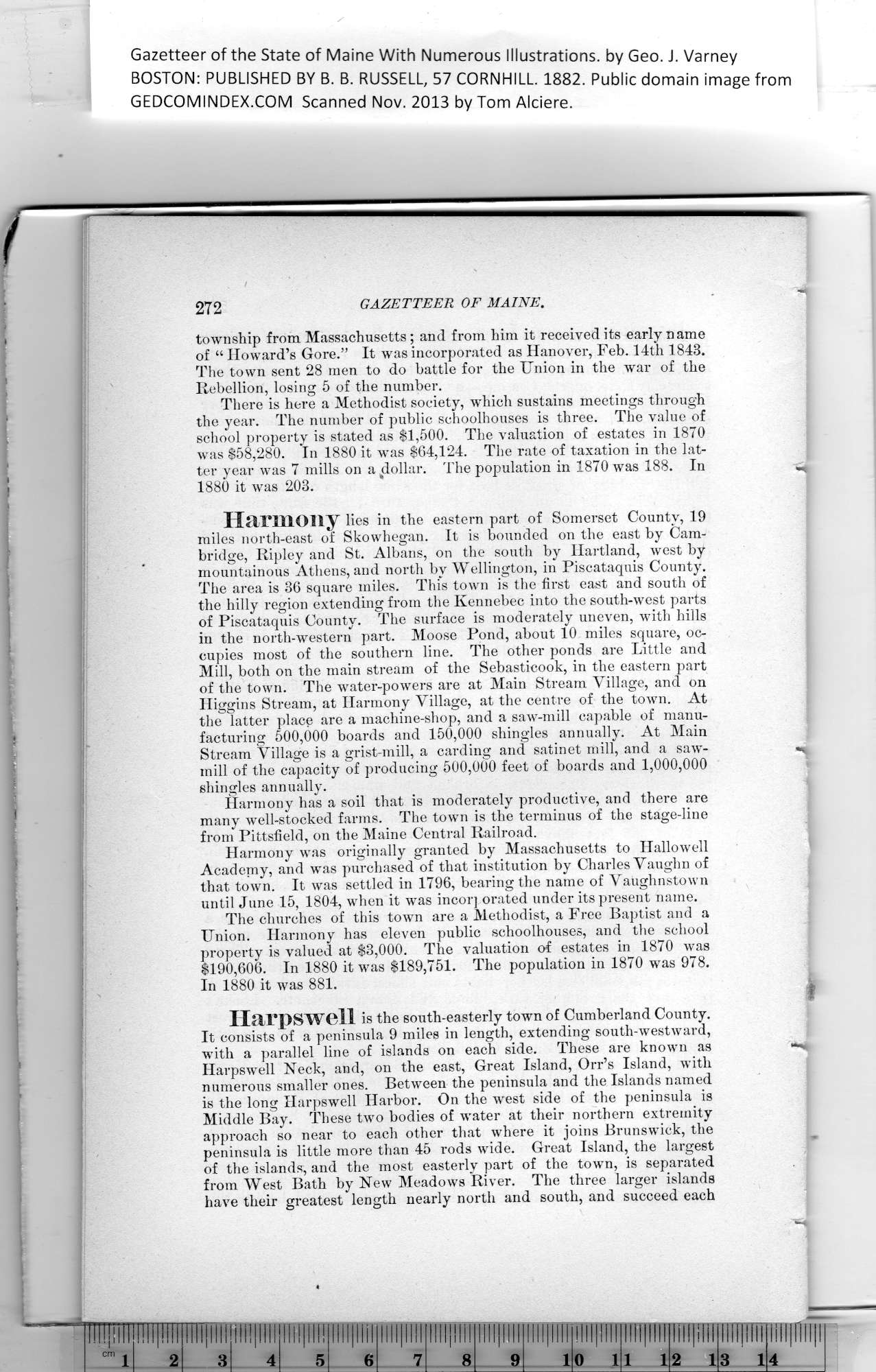|
Gazetteer of the State of Maine With Numerous Illustrations, by Geo. J. Varney
BOSTON: PUBLISHED BY B. B. RUSSELL, 57 CORNHILL. 1882. Public domain image from
272 GAZETTEER OF MAINE.
township from Massachusetts; and from him it received its early name
of “ Howard’s Gore.” It was incorporated as Hanover, Feb. 14th 1843.
The town sent 28 men to do battle for the Union in the war of the
Rebellion, losing 5 of the number.
There is here a Methodist society, which sustains meetings through
the year. The number of public schoolhouses is three. The value of
school property is stated as $1,500. The valuation of estates in 1870
was $58,280. In 1880 it was $64,124. The rate of taxation in the lat-
ter year was 7 mills on a dollar. The population in 1870 was 188. In
1880 it was 203.
Harmony lies in the eastern part of Somerset County, 19
miles north-east of Skowhegan. It is bounded on the east by Cam-
bridge, Ripley and St. Albans, on the south by Hartland, west by
mountainous Athens, and north by Wellington, in Piscataquis County.
The area is 36 square miles. This town is the first east and south of
the hilly region extending from the Kennebec into the south-west parts
of Piscataquis County. The surface is moderately uneven, with hills
in the north-western part. Moose Pond, about 10 miles square, oc-
cupies most of the southern line. The other ponds are Little and
Mill, both on the main stream of the Sebasticook, in the eastern part
of the town. The water-powers are at Main Stream Village, and on
Higgins Stream, at Harmony Village, at the centre of the town. At
the latter place are a machine-shop, and a saw-mill capable of manu-
facturing 500,000 boards and 150,000 shingles annually. At Main
Stream Village is a grist-mill, a carding and satinet mill, and a saw-
mill of the capacity of producing 500,000 feet of boards and 1,000,000
shingles annually.
Harmony has a soil that is moderately productive, and there are
many well-stocked farms. The town is the terminus of the stage-line
from Pittsfield, on the Maine Central Railroad.
Harmony was originally granted by Massachusetts to Hallowell
Academy, and wrns purchased of that institution by Charles Vaughn of
that town. It wras settled in 1796, bearing the name of Vaughnstown
until June 15, 1804, when it was incorporated under its present name.
The churches of this town are a Methodist, a Free Baptist and a
Union. Harmony has eleven public schoolhouses, and the school
property is valued at $3,000. The valuation of estates in 1870 was
$190,606. In 1880 it was $189,751. The population in 1870 was 978.
In 1880 it was 881.
Harpswell is the south-easterly town of Cumberland County.
It consists of a peninsula 9 miles in length, extending south-westward,
with a parallel line of islands on each side. These are known as
Harpswell Neck, and, on the east, Great Island, Orr’s Island, with
numerous smaller ones. Between the peninsula and the Islands named
is the long Harpswell Harbor. On the west side of the peninsula is
Middle Bay. These two bodies of water at their northern extremity
approach so near to each other that where it joins Brunswick, the
peninsula is little more than 45 rods wide. Great Island, the largest
of the islands, and the most easterly part of the town, is separated
from West Bath by New Meadows River. The three larger islands
have their greatest length nearly north and south, and succeed each
PREVIOUS PAGE ... NEXT PAGE
This page was written in HTML using a program written in Python 3.2
|
